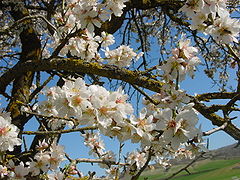Tu Bishvat
| Tu BiShvat | |
|---|---|

Almond tree in blossom on Tu BiShvat
|
|
| Official name | Hebrew: ט״ו בשבט |
| Observed by | Jews in Israel and the Jewish diaspora |
| Type | Jewish religious, cultural |
| Significance | The fruits that ripened from Tu BiShvat on were counted for the following year's tithes if the tree was not in a Sabbatical year. Its role is important to the concept of Chadash. |
| Observances | Tu BiShvat "seder" |
| Date | 15th of Shvat |
| 2016 date | January 25 |
| 2017 date | February 11 |
| 2018 date | January 31 |
| 2019 date | January 21 |
| Related to | Sukkot |
Tu BiShvat (Hebrew: ט״ו בשבט) is a Jewish holiday occurring on the 15th day of the Hebrew month of Shevat (in 2017, Tu BiShvat begins at sunset on February 10 and ends at nightfall on February 11). It is also called "Rosh HaShanah La'Ilanot" (Hebrew: ראש השנה לאילנות), literally "New Year of the Trees." In contemporary Israel, the day is celebrated as an ecological awareness day, and trees are planted in celebration. Its role is important to the concept of Chadash.
The name Tu BiShvat is derived from the Hebrew date of the holiday, which occurs on the fifteenth day of Shevat. "Tu" stands for the Hebrew letters Tet and Vav, which together have the numerical value of 9 and 6, adding up to 15. Tu BiShvat is a relatively recent name; the date was originally called "Ḥamisha Asar BiShvat" (חמשה-עשר בשבט), which means "Fifteenth of Shevat".
Tu BiShvat appears in the Mishnah in Tractate Rosh Hashanah as one of the four new years in the Jewish calendar. The discussion of when the New Year occurs was a source of debate among the rabbis: "And there are four new year dates: – The first of Nisan – new year for kings and festivals – The first of Elul – new year for animal tithes. Rabbi Elazar and Rabbi Shimon say: – The first of Tishrei– new year for calculation of the calendar, sabbatical years and jubilees, for planting and sowing – The first of Shevat, according to the school of Shamai; The school of Hillel says: the fifteenth of Shevat" (Rosh Hashana:2a).
...
Wikipedia
